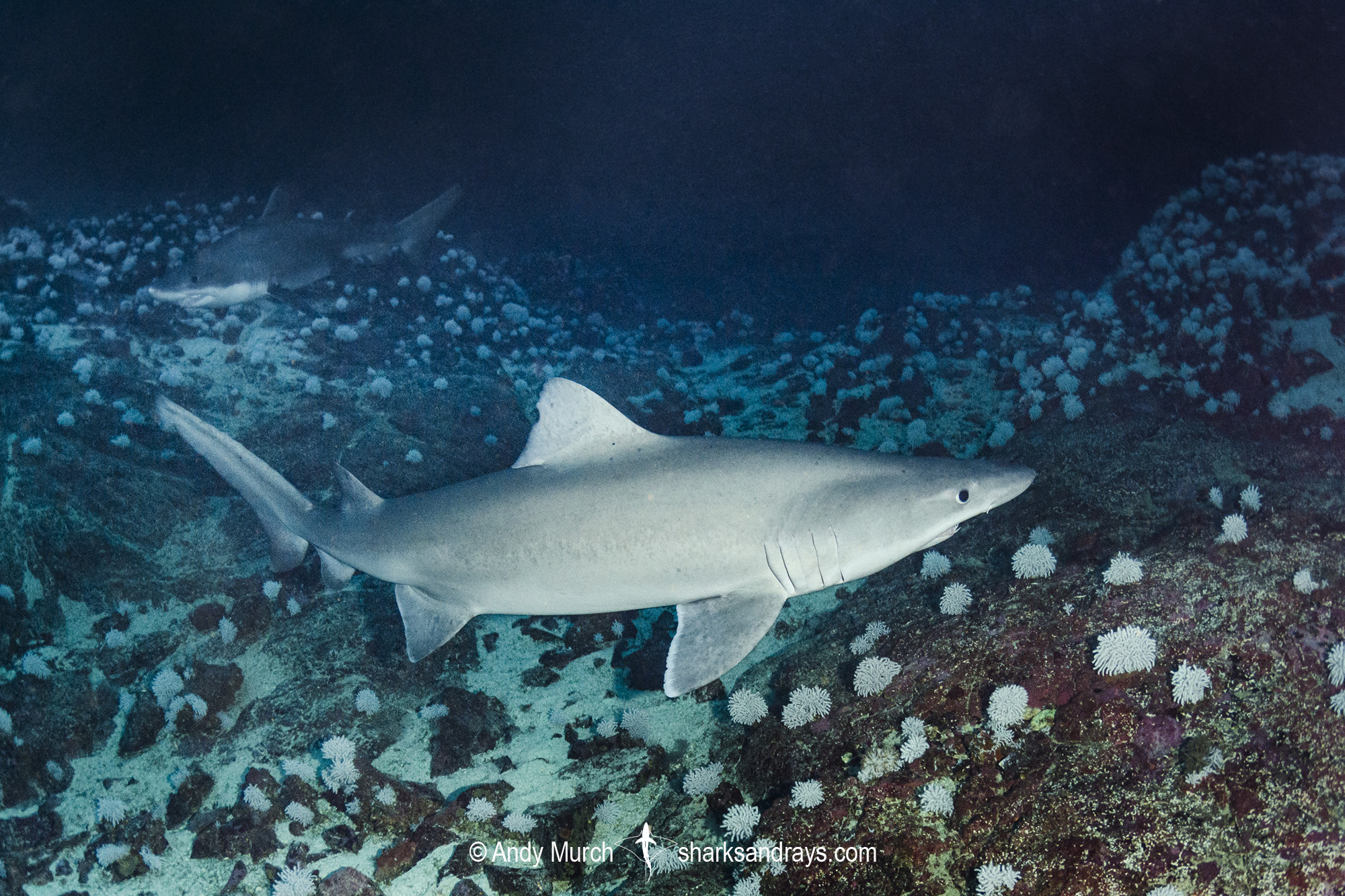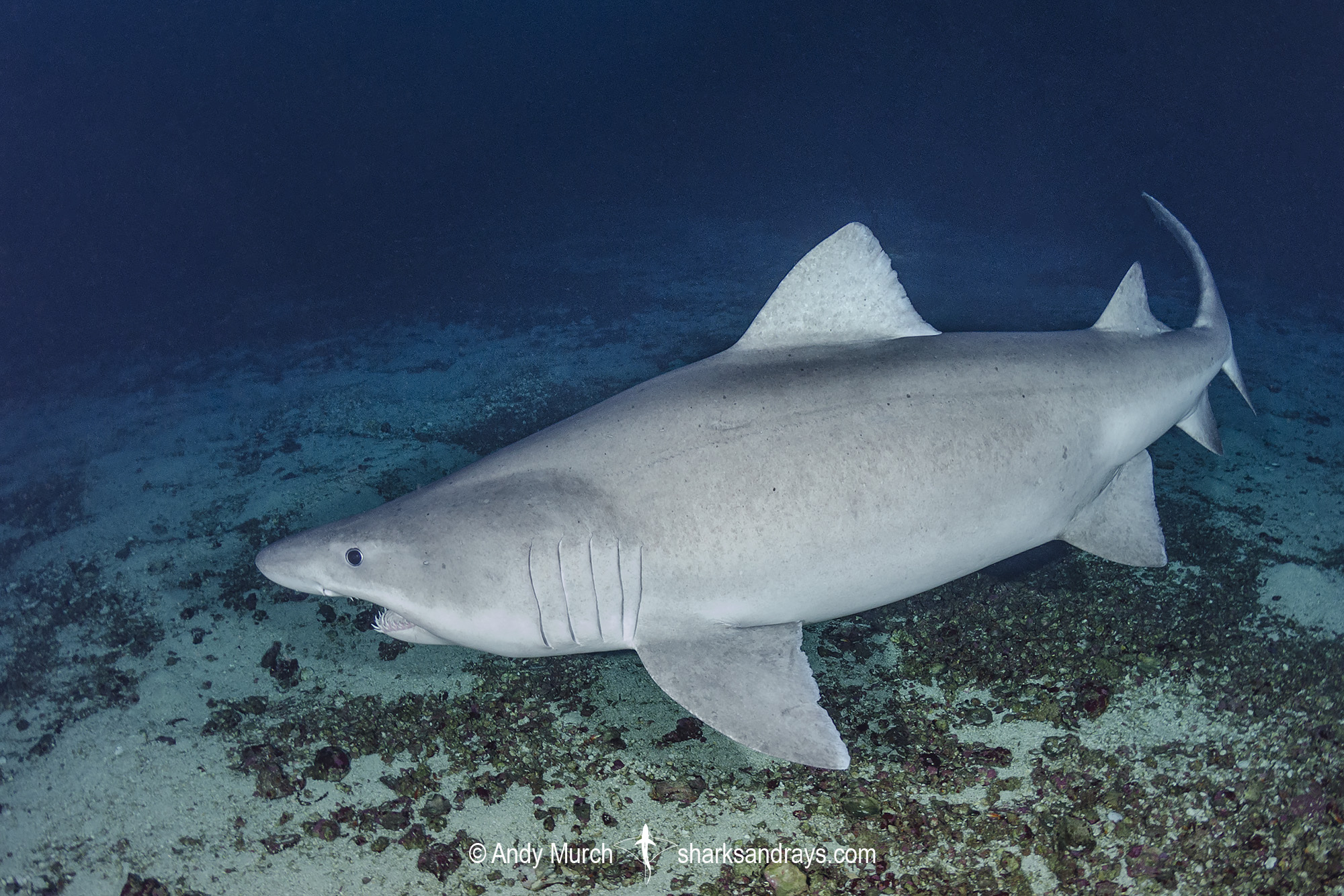Common names
Smalltooth Sandtiger Shark, Sand Tiger Shark, Ragged-tooth Shark.
Binomial
Odontaspis ferox
Synonyms
Carcharias ferox, Odontaspis herbsti, Squalus ferox.
Identification
A large, heavy-bodied shark. Snout conical with a rounded tip. Teeth in the lower jaw are curved and protrude even when mouth is closed. Angle of first dorsal fin posterior edge, mirrors leading edge. First dorsal fin origin level with free rear tip of pectoral fin. Second dorsal fin large but smaller than first dorsal. Second dorsal fin origin over pelvic fin free rear tip. Well defined pre-caudal notch. Upper caudal lobe has a relatively weak subterminal notch.
Dorsal coloration varies from light grey to pinkish-grey, to reddish brown. Ventral surface off-white. Juveniles often have scattered dark spots or small blotches.
Size
Maximum size 450cm. Size at birth 100-105cm.

Conservation Status
VULNERABLE
Based on the biological traits of the similar sandtiger shark (Carcharias taurus), the Smalltooth Sandtiger (Odontaspis ferox) is presumed to have a late maturity, long gestation, and small litters leaving it vulnerable to localized depletions. Although it is caught in small quantities as bycatch in many countries, little is known about its population stability.

Habitat
Warm-temperate/sub-tropical continental shelves, upper slopes, and oceanic sea mounts. Usually close to the substrate but may be epi-pelagic as it is sometimes caught over very deep water i.e. 2000-4000m. Depth range 10-880m.
Distribution
Although rarely encountered, disjunct populations occur in most temperate environments including Algeria; Australia (New South Wales, Victoria, Western Australia); Brazil (Fernando de Noronha, Rio Grande do Norte, São Paulo); British Indian Ocean Territory; British Indian Ocean Territory; British Indian Ocean Territory (Chagos Archipelago); Cabo Verde; Chile; Cocos (Keeling) Islands; Colombia; Colombia; Colombia (Malpelo I.); Costa Rica; Costa Rica; Costa Rica (Cocos I.); Croatia; Cyprus; Ecuador; Ecuador; Ecuador (Galápagos); France; Greece; Indonesia; Indonesia; Indonesia (Jawa); Israel; Italy; Italy; Italy (Italy (mainland)); Japan (Honshu); Lebanon; Madagascar; Maldives; Malta; Mexico; Morocco; New Caledonia; New Zealand (Kermadec Is., North Is.); Portugal; Portugal; Portugal (Madeira, Azores); South Africa (KwaZulu-Natal); Spain (Spain (mainland), Canary Is., Baleares); Sri Lanka; Syrian Arab Republic; Taiwan, Province of China; Tanzania, United Republic of; Tunisia; Turkey; United States (Alabama, California, Florida, Georgia, Hawaiian Is., North Carolina, South Carolina); and the Western Sahara.
Reproduction
Presumably aplacental viviparous and oophagous like other lamnids, but no gravid females have been examined. In the related santiger shark, embryos indulge in ’embryonic cannibalism’.
Diet
Small bony fishes, squid, and shrimp.
Behavior
The smalltooth sand tiger is known to form small groups in relatively shallow water. Behavior poorly known.
Reaction to divers
Easily approached with slow non-threatening movements. Chumming is not necessary to encounter this species where it naturally occurs.
Diving logistics
There are three locations where smalltooth sandtigers may be seasonally encountered but in each spot, sightings are hit and miss.
Probably the most reliable location is at a seamount named Bajo Del Monstruo, next to Malpelo Island in the eastern tropical Pacific. The best months for encounters are January to March. For reasons known only to the sharks, smalltooth sandtigers congregate on one small, 60-70m deep reef slope. They are rarely encountered elsewhere around the island, but random encounters do occur; sometimes in much shallower water.
Off the northwest coast of Africa, smalltooth sandtigers sometimes enter very shallow water (10m deep) at reefs around El Hierro Island in the Canary Islands. Sightings generally occur in the summer.
Apparently, smalltooth sandtigers also occur at a dive site named Shark Point. Divers interested in this dive should contact dive shops in Beirut for further information.
Similar species
Sandtiger Shark Distinguished by more slender body, and second dorsal which is the same size as the first.
Bigeye Sandtiger Distinguished by larger eyes. An extremely rare species, confined to deep water greater than 600m.






